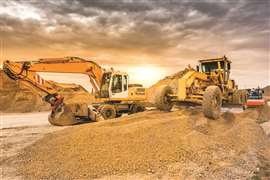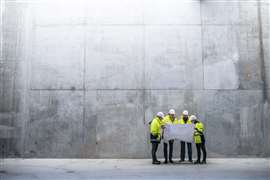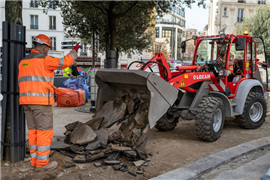Read this article in Français Deutsch Italiano Português Español
Liebherr LR 1300 comes of age and keeps on going
22 October 2025
As it turns 18, the 300 tonne capacity LR 1300 lattice boom crawler crane continues to be a best seller for manufacturer Liebherr. Alex Dahm talked to its desiger about the secrets of its success
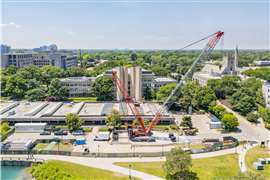 Interchangeable components in a Liebherr fleet are a key advantage. Photo: Liebherr
Interchangeable components in a Liebherr fleet are a key advantage. Photo: Liebherr
As it turns 18 years, the 300 tonne capacity LR 1300 lattice boom crawler crane continues to be a best seller for manufacturer Liebherr. Holger Streitz, technical managing director at the Liebherr plant in Nenzing, Austria, explained the secrets of its success and a little of its background to Alex Dahm.
In the same way as the car industry and many others, cranes are subject to multiple combinations of updates, upgrades, facelifts and design improvements throughout their lives, especially as once-new or future technologies become practical propositions and can be incorporated.
What are the decisive factors in determining when changes made to a crane constitute an update or its designation as a new model? Over time design changes and developments often become more incremental than fundamental, squeezing that extra little bit of performance or efficiency.
When might you expect to reach the practical limits of improving an existing design? In the case of Liebherr-Werk Nenzing’s second largest model, the LR 1300, it has turned 18 but is still going strong. Before attempting to establish the secrets of eternal youth we went back to the beginning.
Alex Dahm: What prompted the design, development and introduction of the LR 1300 lattice boom crawler crane in the first place, 18 years ago?
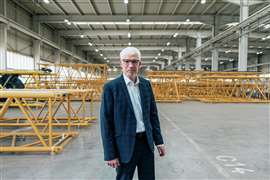 Holger Streitz, technical managing director at the Liebherr factory in Nenzing, Austria. Photo: Liebherr
Holger Streitz, technical managing director at the Liebherr factory in Nenzing, Austria. Photo: Liebherr
Holger Streitz: At the time, our internal market research identified a gap in the 300 tonne lifting capacity range. Liebherr’s aim was to close this gap and expand our crawler crane portfolio.
As a young engineer, who had just joined the product development department, I was given the challenge of developing the first crawler crane at the Nenzing site. In those early years, we launched a new crawler crane model every year. We began with smaller machines. The largest among them was the LR 1280. Our customers encouraged us to continue the concept of the LR 1280 but to develop it with even more lifting capacity. This direct feedback ultimately led to the development of the LR 1300.
Looking back the LR 1300 has been a significant milestone – not only for our customers, who gained a highly capable machine, but also for our plant in Nenzing.
The LR 1300 was first unveiled at the Bauma trade show in 2007. Now, 18 years later, we are proud to have shown the LR 1300 with a battery-electric drive at the 2025 Bauma – a symbol of how the product has evolved and matured over time.
AD: What is so special about it, what was unusual about it at the time?
HS: The crane was based on a “taxi crane” concept. A design philosophy focused on quick assembly and dismantling, enabling efficient transport and frequent mobilisation between sites. It combined two things: high lifting capacity and outstanding mobility. For customers, this meant lower logistics costs and faster readiness for operation, which was a major advantage compared to other cranes in the 300 tonne class.
The development drew on Liebherr’s decades of experience in duty cycle crawler cranes at Nenzing. Many of the design principles were transferred directly, giving the crane both robustness and efficiency – qualities that are still visible in our crawler cranes today.
AD: Why has the LR 1300 remained in production for so long?
HS: The LR 1300 has remained in production for so long because it fills a unique and versatile spot in the market. When it was introduced 18 years ago, it essentially created a new class of 300 tonne crawler cranes – large enough for demanding lifts but still compact and mobile enough for everyday jobs. That balance made it attractive to a very wide range of customers.
Another reason for its longevity is continuous development. Over the years, the crane has been upgraded with modern assistance systems, safety features, digital planning tools, and most recently even a battery-electric drive. In other words, it has grown with customer needs instead of standing still.
For many fleet owners, the LR 1300 has become a reliable standard: a crane that delivers a strong return on investment through its flexibility, durability, and broad application range. That combination of adaptability and proven performance explains why it has stayed in production for nearly two decades.
AD: How many units have been produced and how does this compare with other models?
HS: We have already produced a pretty high three-digit number of the LR 1300 crawler crane models. About 40 per cent of the Nenzing LRs are LR 1300. According to our sources, it is the most popular model in its class. The LR 1300 is also the most popular model of the Liebherr-Nenzing crawler crane range.
AD: What has changed, technically, over the years?
HS: As we manufacture many of the key components ourselves, we can offer our customers perfectly matched overall concepts. Over the years, the crane has been further developed in many ways. The emission values of the diesel engine have been adapted several times to comply with changing legal requirements.
In terms of safety during crane operation, there is the newly developed feature of hydraulic ground pressure reduction plates, which can be used to reduce the ground pressure by more than half.
Increased comfort in the cab also makes daily work easier for the driver. Continuous optimisations of the hydraulics and controls simplify and facilitate the handling of the machine.
In addition, many smart suggestions or wishes from our customers have been implemented over the years – they are the experts on the jobsites. Liebherr always endeavours to offer our customers a safe and unique product experience.
AD: What are some of those changes or additional features requested by customers and incorporated into the machine?
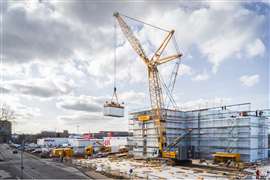 It is unusual to have a derrick system on a 300 tonne class crawler crane. Photo: Liebherr
It is unusual to have a derrick system on a 300 tonne class crawler crane. Photo: Liebherr
HS: Close collaboration with our customers has always been the foundation of the LR 1300’s development. Feedback from operators on the job site has directly inspired many of the innovations setting the crane apart today.
Over the years, we have introduced assistance systems that significantly improve safety, ergonomics, and ease of operation – for example, the Vertical Finder to prevent diagonal pull, the Horizontal Load Path for more precise lifting, and Boom Up-and-Down Assist to make assembly safer and more efficient. The real-time load moment limitation has expanded safety even further, covering not only the lifting of goods but also applications such as personnel lifting, grab and foundation work, or barge operations.
Digital tools have also played a key role, such as site planning software that helps customers prepare projects more efficiently. What makes these solutions unique is their practicality – they were developed not in isolation, but in direct response to customer needs. That close dialogue ensures the LR 1300 continues to evolve in ways that deliver tangible benefits on the job site.
Looking ahead, we will keep building on this approach, further developing the LR 1300.1 SX with innovative technologies that combine well-thought-out engineering with real customer value. (The designation SX stands for a stronger main boom, with the aim of improving the machine’s load capacity curves.)
AD: Is it unusual to have a derrick system on this size of crane?
HS: Yes, the LR 1300 and its predecessor the LR 1280 were the smallest crawler cranes with a derrick system. Up to that point, derricks were normally reserved for much larger cranes but on the LR 1300 it gave customers access to significantly higher lifting performance without moving into a larger crane category. Looking back, this combination of mobility, versatility and heavy-lift capability, made the LR 1300 a real innovation in its class.
AD: What proportion of customers buy the derrick system?
HS: Only around 10 per cent of lifts in the 300 tonne class actually require a derrick system, which explains why not every customer chooses to invest in it. For most standard lifting operations, the base LR 1300 is more than sufficient. The derrick really comes into play for special applications like heavy industrial lifts.
The system is especially popular among fleet owners and larger rental companies. They often purchase one or two derrick kits and keep them available across several LR 1300 units. This modular approach gives them maximum flexibility: they can quickly upgrade a crane’s lifting capacity when a project demands it, without having to move into a completely different crane class. For these customers, the derrick system is a strategic investment that opens up new opportunities and broadens the application range of their fleet.
AD: Is it due for an update, will it get one or will it be replaced?
HS: The LR 1300 is not being replaced – instead, it is continuously updated to keep pace with customer needs and industry trends. At Bauma 2025, for example, we introduced the LR 1300.2 SX unplugged, the first 300 tonne crawler crane with a battery-electric drive. This innovation allows completely emission-free operation on site, while still delivering the same lifting performance customers rely on.
This approach ensures that the LR 1300 remains a proven and trusted machine while being continuously updated for the future. The machine has earned a strong reputation among customers worldwide for its versatility, reliability, and long-term value.
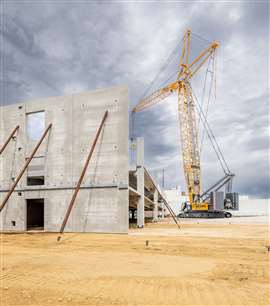 The top three customers for the LR 1300 are in the USA. Photo: Liebherr
The top three customers for the LR 1300 are in the USA. Photo: Liebherr
AD: Why is it so popular in the USA?
HS: The USA has always been a crawler crane country – for historical reasons, many jobsites there are designed around the use of crawler cranes. In this environment, the LR 1300 quickly found its place because of its flexibility, speed, and versatility. Its ability to be assembled and dismantled quickly, combined with a wide range of configuration options, makes it ideal for the diverse applications found across the country.
Another key factor in its success was the strong support from major rental fleets and large construction companies in the USA. They immediately recognised the advantages of the LR 1300 and helped establish it in the market. By putting the crane to work and exposing it to a broad range of applications, they demonstrated its value to the wider industry. This combination of technical strengths and early adoption by influential customers has made the LR 1300 one of the most popular cranes in its class in the United States.
AD: Where else is it a strong seller and why?
HS: The LR 1300 is successful in all our markets without exception thanks to its outstanding features. In addition to the US and Canadian markets, the European market, the Middle East and Australia are particularly important.
AD: Which customers own the most units, why and where are they?
HS: The top three owners of LR 1300s are based in the USA: two are large rental customers and one is a large construction company. They all love the LR 1300 due to its flexibility, operator friendliness, easiness to maintain and repair and uptime. In addition, they like that the crane is very fuel efficient. All of them see the advantage of having different LR models in their fleet and interchange components and boom, luffer and fixed jib systems.
AD: What are typical applications for the LR 1300 (and maybe some unusual ones too)?
HS: Lifting work on land; lifting work on floating structures; heavy duty lifting on land; lifting work as part of foundation work.
Due to its ingenious transportability, the crane can be used for unusual applications, such as the construction of dams in high mountain regions. Our cranes have built stadiums, bridges, power plants, Antarctic research facilities, renewable energy, parking garages, battery plants, data centre – lifted air conditioning systems, tunnel boring machines, pre-cast-elements, housing modules, etc… you name it!
AD: How has the electric version been received – what do LR 1300 customers say about it and what do potential new customers say about it?
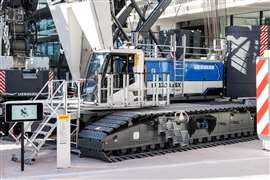 Latest iteration: the LR 1300 was shown in fully battery-electric form at the 2025 Bauma trade show as the LR 1300.2 SX unplugged. Photo: Liebherr
Latest iteration: the LR 1300 was shown in fully battery-electric form at the 2025 Bauma trade show as the LR 1300.2 SX unplugged. Photo: Liebherr
HS: The LR 1300, respectively the LR 1300.2 SX unplugged, was well received when it was presented to the public at Bauma 2025 in Munich. We often heard customers like the quietness of the machine, the local zero emissions and the new access to the cabin. Our customers also appreciate the fact the crawler crane’s battery can be fully charged within 4.5 to 8.5 hours and that crane operation can continue as usual during this time.
AD: Is the future of battery-electric mobile machines to have easily exchangeable, standardised batteries (like giant AA, AAA, etc)?
HS: There is certainly a strong trend toward battery standardisation, and the idea of easily exchangeable, “giant AA or AAA” batteries is appealing. In practice, however, the situation is more complex. Different applications require different energy densities, charging strategies, and safety concepts, and battery technology itself is developing at a rapid pace. That makes it difficult to predict a universal format in the near future.
At Liebherr, we take a technology-open approach: our development teams aim to find the optimal solution for each specific machine and application. The wide variety of machines and operational requirements means there is no one-size-fits-all solution.
STAY CONNECTED


Receive the information you need when you need it through our world-leading magazines, newsletters and daily briefings.
CONNECT WITH THE TEAM









